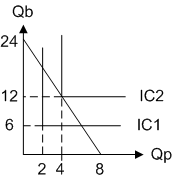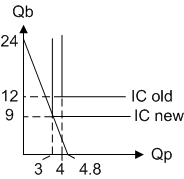Syracuse University
Solution
- To figure out Irene's consumption bundle, combine her budget constraint with the information that she always consumes 3 beers with each pizza (Qb = 3*Qp). The algebra goes as follows:
M = Pb*Qb + Pp*Qp
M = Pb*(3*Qp) + Pp*Qp
M = (3*Pb + Pp)*Qp
Qp = M/(3*Pb + Pp)
Qb = 3*Qp = 3M/(3*Pb + Pp)When M=$24, Pb=$1 and Pp=$3, Qp will be 4 and Qb will be 12. As a check, the total cost of that bundle will be: $3*4 + $1*12 = $24. The diagram showing her equilibrium looks as follows:

- Irene's new consumption can be found using the demand curves derived above. Here's how the numbers come out:
Qp = $24/(3*$1 + $5) = $24/$8 = 3
Qb = 3*$24/(3*$1 + $5) = $72/$8 = 9The corresponding graph is shown below:

- To determine the income and substitution effects, consider compensating Irene so that she can reach her original indifference curve at the new prices. Doing so would move her budget constraint out to BC3, as shown in the diagram below.

Because she regards the goods as perfect complements, returning her to her original indifference curve requires that she be returned to her original consumption bundle. The substitution effect is, therefore, zero since her original and compensated consumption of pizza is exactly the same. The income effect is thus -1 pizzas.
- The CV is the income needed for her to consume her original bundle at the new prices, less her actual income:
CV = $5*4 + $1*12 - $24 = $32 - $24 = $8
The revenue raised by the policy will be $2*3 = $6.
URL: https://wilcoxen.maxwell.insightworks.com/pages/1356.html
Peter J Wilcoxen, The Maxwell School, Syracuse University
Revised 11/08/2004
